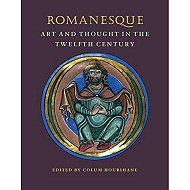|
Romanesque: Art and Thought in the Twelfth Century
|
|
Edited by Colum Hourihane
|

|

Preface
One of the most problematical periods in medieval art history has to be the Romanesque. It was both a period and style that was originally subsumed by the Gothic and was not to gain its independence until relatively late and, in many ways, that was its ruination. As a stylistic term it was used as a single descriptor to define a huge geographic area as well as a long period of time, neither of which, in many ways, appear as a cohesive whole. It was also a term that was particularly Franco-centric and even within that country there is a relative lack of unity. Notwithstanding those problems, some of which are highlighted in the fine essays in this volume, it is also a period that has justifiably excited many.
In the historiography of medieval art it is clear that the most fertile period for the study of Romanesque was in the mid- to late- twentieth century, when pioneering scholars tackled the analysis of style, period, and iconography. Even though there is no agreement as to how involved modern scholarship is with the Romanesque, it is clear that over the last few years there has been a relative slowing down in the number of students and established scholars who are undertaking research in the period. It was with this in mind that the conference whose proceedings are in this volume was first conceived. The aim was both to see why there was this falloff in scholarship in the period and also to engender renewed interest. […]
Despite our efforts to be as comprehensive as possible, it is also clear that there are omissions, but these, I hope, are minor. Our aim was to provide a coverage of different media, from glass to sculpture, and geographic areas, from Italy to England. […]
|
|
